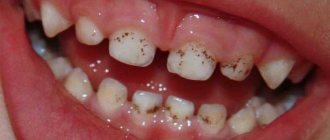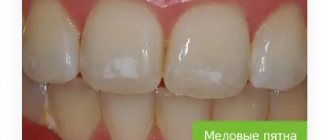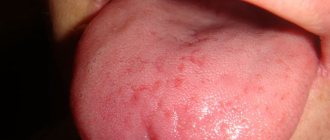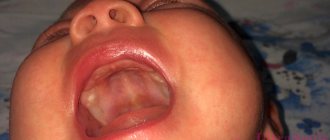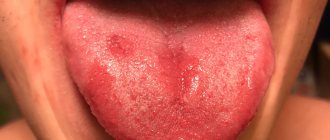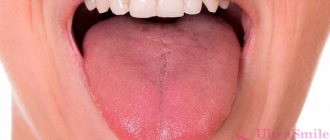July 3, 2020
If you notice a white spot on your or your child’s gum, this may be a sign of various diseases that require treatment by a dentist. Sometimes white spots on the gums do not pose a serious danger, but they still require careful monitoring, as well as the use of measures that will help prevent their systematic occurrence. We suggest reading the article from the UltraSmile.ru portal to find out the most common reasons why, according to experienced doctors, this symptom appears.
First reason: traumatic damage to the mucosa
If a white spot appears on the gum, then the first thing you might think of is a mucosal injury. It seems that the reason is not so dangerous, but there is no need to think so, because often the cause is not only the consumption of sour, hard, too hot or spicy food, but also other circumstances:
- malocclusion,
- wearing poorly made, incorrectly installed bridges, crowns, removable dentures,
- decayed teeth,
- aggressive oral hygiene, abuse of highly abrasive pastes, use of brushes with hard bristles,
- smoking.
The cause of the pathology may be injury to the mucous membrane.
All of the above causes cause systematic injury to the mucous membrane of the oral cavity. If they are not eliminated, white spots on the gums can become a serious problem, develop into malignant formations or provoke the appearance of various diseases.
Causes
- Weakened immunity. In people with weak immunity, the body's resistance decreases. Candida begins to multiply quickly.
- Hormonal imbalances. Changes in hormonal levels lead to various pathologies, and candidiasis is one of them.
- Pathologies of the gastrointestinal tract.
- Diabetes.
- Long-term use of antibiotics. These drugs disrupt the normal microflora. They kill not only pathogenic microorganisms, but also beneficial bacteria.
- Dental diseases. Candidiasis can be provoked by caries and inflammation in the oral cavity.
- Poor oral hygiene. Patients who do not pay proper attention to hygiene are more susceptible to white plaque.
- Dentures. An incorrectly selected denture puts pressure on the mucous membrane, causing it to rub. In these places, the color changes and the tissue structure is disrupted.
- Damage to the mucous membrane. It performs a protective function. Damage provokes various dental pathologies.
White plaque in the mouth is a sign of more than just candidiasis. It also accompanies other pathological conditions:
- Tooth cyst. This is a protective neoplasm that forms in response to the inflammatory process. When pathological cells die, a cavity with dense walls is formed around the necrosis zone, inside which there is liquid.
- Leukoplakia. This is a dense white growth on the gums and cheeks. Without treatment it leads to keratinization.
- Oncological diseases in the initial stage.
Sometimes a problem arises as a response to external irritation. For example, after brushing or whitening your teeth. In this case, it goes away on its own after some time.
Dentistry for those who love to smile
+7
Make an appointment
Second reason: stomatitis
A white spot on the gum that hurts may indicate a disease such as stomatitis. Stomatitis very easily appears against the background of systematic trauma to the mucous membrane and infection inside the wound. The pathology is especially common in infants and young children.
There are many different forms of stomatitis: traumatic, viral, candidal, vesicular, bacterial, allergic, prosthetic. There are also different forms and stages of the disease: catarrhal, aphthous, ulcerative gangrenous. Moreover, each of them has its own distinctive features, signs and symptoms. For this reason, pathology should never be treated independently, because different drugs are prescribed for each type and form.
The photo shows stomatitis
A white spot on the gums of an adult, indicating stomatitis, often occurs due to trauma to the mucous membrane from chipped unrestored teeth, poorly made dentures or poorly installed orthodontic structures. Stomatitis of an infectious nature is more common in children.
Prevention
To avoid the appearance of white plaque on the cheeks, tongue and gums, you must:
- observe the rules of personal hygiene - wash your hands thoroughly after visiting public places, brush your teeth twice a day (including using dental floss and special mouth rinses);
- promptly eliminate foci of chronic infection in the body;
- regularly visit the dentist, sanitize the oral cavity, treat caries, pulpitis and other “local” pathologies.
You should not prescribe medications (including antibiotics) on your own without a doctor’s recommendations - this can lead to an immune failure in the body and, as a result, lead to the development of candidal stomatitis and other diseases of the oral mucosa of bacterial, fungal, and viral origin.
Third reason: cyst
Is there a white spot on the gum above the tooth that hurts? It is likely that you have a cyst. This pathology occurs due to untreated or poorly treated dental diseases: caries and pulpitis, periodontitis. For a long time, the cyst may remain unnoticed and not cause discomfort, but as it grows it makes itself felt.
A cyst may be the cause of a white spot
If it comes to the point that you see a white formation on the gum, then this means that the cyst has grown to a significant size, and you have not undergone preventive examinations at the dentist for a long time, otherwise the problem would have been diagnosed long ago.
Fluorosis
Fluorosis is a dangerous dental disease that is caused by consuming extremely large doses of fluoride. Usually this substance enters the human body along with tap water. In addition, the source of fluoride can be the work environment or even the wrong toothpaste.
Fluorosis begins with the appearance of white, dull spots on the surface of the teeth. They are not always visible to the naked eye. Over time, the spots change color - they first turn yellow, then turn brown. If you don’t consult a dentist at this point, fluorosis can turn into erosive or destructive forms - when the disease begins to destroy the enamel.
Treatment of fluorosis is almost always conservative. The dentist remineralizes the enamel, restoring the balance of calcium, phosphorus and fluoride. Darkened areas are bleached. In addition, the patient is recommended to change his lifestyle to reduce the amount of fluoride consumed - for example, install a special water filter at home or change his place of work.
Fluorosis is often “epidemic” in nature. If it is caused by an increased content of fluoride in tap water, it develops in the whole family. If the reason was a violation of industrial safety - for the entire team. In the Ryazan region, fluorosis is often detected in residents of the Rybnovsky, Chuchkovsky and Shatsky districts, where the water contains an increased amount of fluoride.
Fourth reason: fistula
A fistula is a consequence of untreated or poorly treated dental diseases. The inflammatory process begins in the soft tissues next to the diseased tooth; as it grows, first serous and then purulent fluid accumulates, which begins to put pressure on the tissue and look for a way out - this is how a specific channel for the release of pus is formed - a fistula.
A fistula on the gum is a white spot with a hole in it, and the new growth hurts. But if the pus begins to come out, then the discomfort and pain temporarily disappear, and the spot itself decreases in size. However, this does not mean that the disease has receded, it has simply entered a chronic stage.
An ulcer may symbolize the presence of a fistula
Why does light plaque form on the gums and what does it mean?
Ideally, the gums should have a uniform pinkish color. If suspicious white spots appear on the oral mucosa, you should be wary - most often they indicate the presence of some pathological processes in the body. The reason for the formation of white plaque on the gums may be a low level of hygiene or, for example, a whitening procedure. However, a similar symptom can also be provoked by a serious illness - leukoplakia, abscess, oncology. Read further in this article about possible causes of the problem and ways to solve it.
Fifth reason: leukoplakia
White scaly spots on the gums of an adult or child can be a harbinger of a very dangerous precancerous condition - leukoplakia. New growths of whitish color can also cover the palate and tongue. The bad thing is that the pathology is almost asymptomatic, the patient does not experience pain or serious discomfort. If the white spot becomes cloudy and turns grayish, this indicates that the neoplasm has transformed into a malignant form.
White spots may indicate leukoplakia
How to recognize the problem
How to understand that white plaque signals a problem?
If the gums heal well, then within 2-3 days after surgery the pain becomes very weak and barely noticeable. The wound closes with a dense clot and practically does not bother the person. With the development of alveolitis on days 3-5, the pain, on the contrary, intensifies. It's pulsating. It can become unbearable. Sometimes it radiates to the entire half of the face. Body temperature rises, lymph nodes enlarge, appetite decreases, salivation becomes stronger. The face may also become swollen.
In such a situation, staying at home is dangerous - inflammation can spread to the deep tissues of the jaw. You need to immediately go to the dental clinic.
Sixth reason: wen, or lipoma
Yes, yes, there are wen in the mouth too. In this case, the white spot on the gum should not hurt. The problem may appear due to hormonal imbalance or injury. The wen increases in size very slowly and does not pose a serious danger. Doctors say that the likelihood of its degeneration into a malignant tumor is very low, but if the pathology recurs (for example, if it appears again after laser removal), it is better to perform a biopsy to rule it out.
The photo shows a wen
Wen represent only an aesthetic problem, but, growing to large sizes, they can cause discomfort and be constantly injured. Large tumors are recommended to be removed by surgery.
Light plaque on the gums is not a reason to panic
Plaque on the oral mucosa is a breeding ground for pathogenic bacteria. In the absence of any pathological processes in the body, such a symptom may indicate insufficient hygiene. Usually natural plaque can be detected in the morning after waking up, in which case it can be easily removed with a regular toothbrush and paste. Its presence on the tongue and gums is a completely natural and normal phenomenon, which provides a certain degree of protection of the oral cavity from pathogenic microflora. However, if a person does not systematically brush his teeth and take care of his oral cavity, the plaque on the teeth near the gums will very soon begin to harden and eventually turn into tartar, which can only be removed in the dentist’s office.
White plaque on the gums, why does it occur?
Another question is if you can’t remove the film yourself. In such cases, it usually has a dense consistency and can appear either in the form of a continuous covering or in the form of plaques. This symptom indicates the presence of any pathological processes in the oral cavity or in the body, so in this case you should definitely consult a doctor. It will be possible to cope with the problem only after making an accurate diagnosis, and any attempts to eliminate plaque on your own will not lead to the desired results, if they do not aggravate the situation at all.
Seventh reason: suppuration after tooth extraction
Alveolitis can be mistaken for a white spot on the gum of an adult, which formed after tooth extraction and hurts. In this case, the socket of the extracted tooth becomes inflamed and becomes covered with a whitish (grayish) coating. All this may be accompanied by an increase in body temperature, discharge of pus from the wound, swelling of the soft tissues, and bad breath.
Alveolitis occurs after tooth extraction
If you have alveolitis, you need to see a doctor as quickly as possible, and for this there are 3 compelling arguments, which you can read about in the feature article on our website.
Symptoms
White plaque on the gums of an adult with stomatitis “makes itself known”, first of all, by the appearance of blisters, ulcers, and inflamed lesions on the oral mucosa. There are many reasons for the development of stomatitis in an adult - bad habits, immune failure in the body, malocclusion, hypothermia and poor daily oral care.
Important! Stomatitis can be of a fungal, bacterial or viral nature; the appearance of white plaque on the mucous membrane is usually preceded by infection of the gums by the Candida fungus (candidal stomatitis).
If the gums in your mouth suddenly turn white, this may indicate the presence of an infection in the root canal and the development of a dental cyst. This formation, as a rule, occurs as a result of untreated caries (pulpitis) or is a consequence of poor-quality filling of the dental canals. A cyst is a bone cavity filled with purulent exudate. Visually manifests itself in the form of a compaction; the gums on which the formation is located are inflamed, hyperemic, and covered with a white coating.
Aphthous stomatitis (a bacterial infection that affects the oral mucosa) occurs in children and adults, accompanied by the appearance of numerous white formations (aphthae) on the cheeks, gums, and palate
Increased keratinization of the epithelium with accompanying thickening and desquamation is called leukoplakia. In this case, whitening of the tongue and gums is accompanied by the appearance of thickened areas of mucous membrane on the cheeks and corners of the mouth. The whitened plaques characteristic of leukoplakia harden over time. The course of this disease is usually almost completely asymptomatic and painless. True, the mucous membrane of the mouth that turns white near the tooth becomes sensitive to hard, hot or cold food.
Reasons for the development of leukoplakia:
White coating on the root of the tongue
- injuries to the delicate mucous membrane of “rough” food;
- poor-quality filling of teeth after treatment of caries, pulpitis and other dental diseases;
- poor prosthetics;
- bad habits;
- lack of proper oral hygiene;
- disruption of the digestive tract;
- vitamin A deficiency in the body.
Important! People diagnosed with leukoplakia are at risk of developing “full-blown” gum cancer.
It is noteworthy that a pale film on the gums can occur after a routine professional teeth cleaning at the doctor's office or as a result of prolonged use of mouthwash. If such a formation appears after visiting the dentist, do not panic - as a rule, the film will disappear on its own in a few days.
When the “culprit” of a light white coating is a rinse aid, it is better to immediately discard such a hygiene product or replace it with a suitable analogue. And yet, according to medical statistics, the main cause of white gums in infants and adult patients is candidal stomatitis, an unpleasant fungal disease. Candida fungus causes a characteristic cheesy coating to appear on the gums, which is easily scraped off even with minimal mechanical impact on the mucous membrane
The main “provocateurs” of pathology:
- immune failure;
- hormonal disorders;
- chronic problems in the gastrointestinal tract;
- anemia;
- diabetes;
- HIV infection;
- long-term use of antibiotics (use of local antiseptics);
- the presence of carious lesions in the teeth;
- gingivitis;
- poor oral hygiene.
Candidiasis of the oral mucosa “makes itself known” by an unpleasant odor from the mouth, a whitish-yellow coating on the gums, tongue, and cheeks, which is easily scraped off with the slightest mechanical impact (a new layer immediately appears in its place). In the absence of timely treatment, this fungal disease can spread to other mucous membranes, affect the skin and even internal organs (for example, the intestines).
Important! Candidiasis in a newborn can be “inherited” from the mother (it becomes infected at birth or during lactation).
Aphthous stomatitis is another “culprit” of white plaque on the oral mucosa. The causative agent - a bacterial infection - causes the appearance of white aphthae (plaques, erosions) on the gums and cheeks, which have a clear red outline and rounded outline. The main reasons for the development of aphthous stomatitis include:
- mucosal injuries;
- food allergies;
- deficiency of vitamins, minerals, microelements in the body;
- foci of infections in the body;
- frequent stress;
- problems with the digestive tract.
The appearance of aphthae in the mouth is accompanied by pain, discomfort in the mouth while eating, hyperthermia, an increase in the size of regional lymph nodes, weakness and general malaise.
A variant of the norm is considered to be a white film on the gums after professional teeth cleaning - it disappears on its own 2-3 days after the manipulation.
In the acute form of aphthous stomatitis, erosions epithelialize within 7–10 days without scarring of soft tissues. When the disease becomes chronic, scars usually remain on the mucous membrane after the aphthae disappears. If a child’s gums are swollen and painful, and white spots of different sizes with a red border appear near it, this is the first sign of measles.
In combination with other symptoms - increased body temperature, weakness, nausea, fever - such plaque is a reason for examination by a pediatrician (pediatric dentist). White spots on the gums appear in a baby before teething - in this case, such formations are not a cause for concern.
It happens that after extraction (removal) of a tooth, a white tubercle appears in the empty socket - this is the protein fibrin, designed to protect the cavity until it finally heals. This phenomenon is a variant of the physiological norm and should not cause any concern.
A white spot on a baby’s gum is a separate topic for conversation
White spots on the gums of young children are of particular concern to parents. Although there are not always reasons to panic. We will list the most harmless reasons why they appear:
- teething: occurs at the age of 4–5 months and older and may be accompanied by others: increased salivation, coughing and nasal discharge, the baby’s desire to put everything in his mouth, restlessness. During this period, you need to carefully monitor the child's condition. If you doubt or suspect that it is not the process of teething that is to blame, but other pathologies and diseases, then contact your pediatrician or dentist,
A baby's teething may be mistaken for a white spot - Bon's nodules: characteristic of newborns. They are smooth, whitish, do not exceed 1–3 mm in diameter1, and are localized mainly in the palate. Dissolve on their own within the first three months of the baby's life.
- Epstein pearls: These can be confused with Bohn's knots. They consist of epithelial tissue, externally resemble small grains or beads, and dissolve on their own. Occurs in 65–85% of all newborns.
“Once I noticed that my little son, who was only one month old at the time, had some white stripes on his gums and lower jaw. When the pediatrician examined him, she said that it was not a strip at all, but a neonatal tooth, an incisor, which began to erupt so early. I was shocked that this happened. The doctor said that although this is a very rare case, it is not critical. Now we need to observe, because... this tooth may end up quietly standing in the row of milk teeth, or it may be supernumerary, in which case it will have to be removed later.”
Maria K, review from woman.ru
In the cases listed above, parents do not need to sound the alarm. However, there are situations in which a white dot on a baby’s gum, especially if it hurts, may indicate candidiasis and stomatitis. Then you need to contact a specialist. White dots can also appear in children due to allergies to food, the introduction of new complementary foods and a change in formula.
If the white dots do not go away for a long time, or appear systematically, then this is a reason to consult a doctor and get examined. The symptom may indicate a violation of calcium metabolism in the body, dysfunction of the endocrine system or vitamin deficiency.
Notice
: Undefined variable: post_id in
/home/c/ch75405/public_html/wp-content/themes/UltraSmile/single-item.php
on line
45 Notice
: Undefined variable: full in
/home/c/ch75405/public_html/wp-content /themes/UltraSmile/single-item.php
on line
46
Rate this article:
( 3 ratings, average: 5.00 out of 5)
gum disease
- Shakovets N.V. Dental examination of young children // Modern dentistry. – 2022.
Expert “If a white dot appears on the gum and it hurts, then this may indicate the presence of an abscess or any other purulent inflammation. Do not self-medicate under any circumstances, do not resort to traditional methods and do not try to squeeze out the tumor - all this can be harmful to health, and the infection will go deep into the body.” Dentist-therapist Elena Vladimirovna Orlova
Consulting specialist
Orlova Elena Vladimirovna
Doctor rating: 9.5 out of 10 (2) Specialization: Dentist-therapist Experience: 33 years
Treatment
Before looking for ways to eliminate white plaque on the tongue, cheeks, and gums, the doctor must determine the cause of its appearance. So, if the problem arose after implantation, traditional teeth cleaning or extraction, you can rinse your mouth with a local antiseptic (the most affordable one is chamomile infusion). The procedure is repeated every 2-3 hours for several days in a row - the plaque should go away.
Important! If there are signs of suppuration on the gum (a fistula or cyst has formed), you should not postpone a visit to the dentist - he will open the formation, remove the exudate, and disinfect the resulting cavity.
For dental cysts, patients are advised to undergo surgical intervention. For candidal stomatitis, the patient is prescribed systemic antifungal drugs (Fluconazole, Nystatin, Pimafucin, Clotrimazole), as well as local agents - ointments, gels (for example, Miconazole). Both dentures and the oral mucosa should be treated with antiseptic solutions (Iodinol, Lugol or regular baking soda diluted with water).
Not least important in the successful fight against stomatitis is diet correction. So, from the daily menu for the entire duration of treatment, sweets, flour products, spicy, sour, salty foods and everything that could injure the already “damaged” mucous membrane are excluded. It is noteworthy that not only dentistry, but also gastroenterology, as well as endocrinology, should search for the causes of candidal stomatitis of the oral mucosa.
Leukoplakia in traditional dentistry is considered to be a disease with a high risk of degeneration into gum cancer.
The fight against leukoplakia involves finding and eliminating the factors that caused the development of the disease. Thus, the oral cavity is “freed” from traumatic dentures, sharp tooth edges are ground, and damaged units are restored.
In addition, systemic treatment of leukoplakia includes diagnosis and treatment of diseases of the digestive tract, endocrine disorders, replenishment of vitamin A deficiency in the body, cessation of smoking and alcohol consumption. Areas of the mucous membrane affected by leukoplakia are excised with a laser, removed using the radio wave method, or excised using an electric knife.
Important! In modern dentistry, they have abandoned the treatment of this disease with liquid nitrogen, since after freezing the hardened lesions, scars remain on the mucous membrane.
Comments
I’m taking a teeth whitening course at home, a kit was given to me by a friend. I began to notice that after the third procedure a white dot appeared on the gum and it hurt. What could it be?
Vika (07/18/2020 at 10:48 pm) Reply to comment
- Dear Vika, there may be several reasons for your problem in this case: an allergic reaction to the components of the whitening composition, traumatic injury and burns as a result of chemical contact with the gums. Before applying whitening preparations, the mucous membrane must be well isolated, safety precautions must be observed, which is quite difficult to do at home, which is why we recommend carrying out whitening procedures in a dental office.
Editorial staff of the portal UltraSmile.ru (07/21/2020 at 09:14) Reply to comment
Hello! Two years ago I had a cyst removed on my gum. About a month ago I noticed that a new cyst had appeared in the same place. It doesn't hurt, but I'm worried about its reappearance. What is this connected with?
Olga (08/21/2020 at 10:16 am) Reply to comment
Hello, 2 spots appeared on the upper gums, I was diagnosed with stomatitis. Antibiotics were prescribed. I took the whole course, but nothing changed. Maybe the diagnosis is wrong?
Oksana (08/21/2020 at 12:04 pm) Reply to comment
A month ago I had a crown installed on my left upper six. The gums around me still hurt, although the doctor said it was normal. Recently I noticed white painful spots above the crown. After rinsing, the pain subsides, but the formations themselves do not go away. Should I go to a specialist or continue rinsing at home?
Nelya (08/21/2020 at 17:50) Reply to comment
Tell me why white spots may periodically form in the gum area of a seven-year-old child, what could be the reason for this, and what treatment is recommended for the child in this case?
Yuliana (08/21/2020 at 09:13 pm) Reply to comment
From time to time, something similar to stomatitis appears on the gums. The gums become inflamed and painful. It bleeds a little. At the site of gum swelling, you can see a white spot. But after 3-4 days everything goes away. What could this be symptoms of?
Olya (08/21/2020 at 11:42 pm) Reply to comment
And if this white spot on the gum constantly appears and then goes away, is it possible to get rid of it for good? What treatment is required and what toothpaste is best to choose in this case?
Raya (08/22/2020 at 02:32) Reply to comment
Please tell me, my child is 2 years old and has some white spots on his gums, not as small as ours in the photo. They don't bother the child. During the examination, the doctor said that there was no need to worry. Is it so?
Alexandra (09/23/2020 at 12:50 pm) Reply to comment
My husband periodically develops a white and very painful spot in the gum area. The reasons for the appearance of this spot are unknown, but during the period when it appears, he cannot fully eat due to pain. How to treat a white spot that periodically forms on the gum?
Sabina (09.23.2020 at 14:56) Reply to comment
A light-colored spot has formed on the teenager’s lower gum; the child complains of pain and discomfort in the mouth. What remedy can you recommend to help the oral mucosa recover faster?
Sonya (09.23.2020 at 15:44) Reply to comment
Initially, unpleasant sensations were observed in the upper gum area, later redness appeared, and even later a white visible spot appeared. What could it be, and how can I cure this spot, since it also hurts.
Violeta (09.23.2020 at 15:49) Reply to comment
Initially, unpleasant sensations were observed in the upper gum area, later redness appeared, and even later a white visible spot appeared. What could it be, and how can I cure this spot, since it also hurts.
Velisa (09.23.2020 at 15:50) Reply to comment
Write your comment Cancel reply
Treatment of white spots on gums
Depending on the diagnosis, the problem is eliminated by a therapist, dentist, endocrinologist, gastroenterologist, infectious disease specialist and other specialists. Therapeutic methods:
- Removal of soft deposits and hard stones.
- Treatment of pathological masticatory organs.
- Using baths and applications.
- Carrying out rinsing with antiseptic substances.
Cysts and granulomas most often require surgical intervention. Classical therapy can be carried out, which involves opening the canals, thoroughly cleaning the passages, and mandatory rinsing with special solutions. New technologies require modern equipment, as well as medicines. For leukoplakia, the doctor eliminates the irritating factors of the disease. Vitamin preparations are prescribed. If fungal infections are detected, complex therapy is carried out, which includes sanitation of the oral cavity, taking medications, and treating the affected areas with antiseptics. The patient must adhere to a diet.
Stomatitis is treated with anti-viral drugs. In case of an allergic reaction, it is recommended to take antihistamines. If you need to remove a fistula, pulpitis and caries are treated first. Fat deposits are removed surgically. A modern method of removal is the use of laser beams. Herpes is easier to prevent. Most often, Acyclovir is prescribed for this disease.
Candidiasis
If a white spot under the gum is easily removed with a cotton swab, but appears again after a while, then this is considered a sign of candidiasis. Candidiasis or thrush is a lesion of the mucous membrane by Candida fungi.
Fungal microorganisms of this kind are present in the normal microflora of the mouth, so the disease does not appear when they penetrate the mucous membrane, but when they multiply intensively. This is usually observed with reduced immunity or dysbacteriosis. Pathological proliferation of fungi is associated with:
- vitamin deficiency;
- decreased immunity due to severe illnesses, especially infectious ones;
- lack of iron;
- dysfunction of the endocrine system;
- dysbacteriosis of the oral cavity.
Candidiasis develops with a decrease in salivation and an increase in the acidity of saliva (this condition is noticed in many gastrointestinal ailments). This disease requires treatment to prevent complications.
What can you do at home?
Treatment can be performed at home, but only after consultation with a doctor. The patient receives a regimen to follow. What can you do before visiting a doctor? There are several recommendations that make the situation easier:
- Whatever the reason for the appearance of white spots, rinsing with an antiseptic solution will improve the condition. It is sold in pharmacies - “Chlorhexidine”, “Furacilin Eludril”, “Etonium”. But you can cook everything yourself. Add salt or soda (1 tsp) to warm water (1 glass). Everything gets mixed up. Rinse procedures can be performed every 2 hours. These measures stop the action of pathological microflora, reduce swelling, itching, and pain.
- You can make an infusion of beneficial herbs. Plants with anti-inflammatory, antiseptic, regenerating effects are needed. Sage, chamomile, calendula, and oak bark are suitable for this. The plants are suitable for brewing either separately or together. To prepare a healing solution, you need crushed herbs (2 tablespoons), which are poured with boiling water. The product is infused for several hours, after which it can be filtered and used for rinsing.
- Propolis has a powerful antibacterial and regenerating effect. For diseases of the mucous membrane, it is allowed to be taken. You can buy the tincture ready-made or make it yourself. To do this, 20 g of the product should be filled with alcohol (70%). After 3 days the product will be ready. Store it for a long time in the refrigerator. To prepare a solution for rinsing, you need to add the prepared tincture (2 tsp) to water (1 glass). The procedure is performed at least 5 times a day.
Experts believe that if white spots on the gums do not disappear on their own within a few days, then you should not self-medicate. Especially if other unpleasant phenomena occur with these symptoms.
Diagnostic and treatment methods
To exclude hidden lesions of the tooth and soft tissues, the doctor refers the patient to an X-ray. Treatment always begins with removal of pus. The specialist carefully opens the gum and cleans it of dead tissue, after which he treats the cavity with antiseptics. To defeat the infection, the patient must take antibiotics and anti-inflammatory drugs prescribed by the doctor. If pathogenic microorganisms have not penetrated into the deep layers of tissue, this is usually enough to stop inflammation.
If the image shows that the main source of inflammation is in the canals of the tooth, then the filling will have to be removed. The doctor will remove it, thoroughly clean the root canals, place a temporary filling and set a date for a follow-up examination. It will be possible to fill the tooth again only after the photo shows that the inflammatory process has stopped.
Sometimes the cause of suppuration is damage to the apex of the tooth root. To save it, the doctor performs an operation - resection. During it, only the affected root tissue is removed.
Treatment of gum suppuration always includes taking antibacterial drugs. They help destroy infectious agents and prevent relapse.
Physiotherapeutic methods are also widely used in dentistry. Electrophoresis, ultrasound and laser help speed up tissue restoration, increase local immunity, and relieve swelling. Physiotherapy is prescribed only after the inflammatory process has stopped. The duration of the course for each patient is determined individually.
Poor quality care
Often whitish, yellowish spots on the gums occur due to poor oral care. They are considered normal plaque, which is not a pathological process. Due to the accumulated and multiplied pathogenic microorganisms, the healthy microflora of the oral cavity is disrupted.
It is necessary to rinse with medicinal plants or a warm soda solution after meals. It is important to brush your teeth regularly. If plaque builds up, it is necessary to use antibacterial rinses several times a day after meals. This restores a healthy environment in the mouth and protects against stains without medications or additional procedures.

